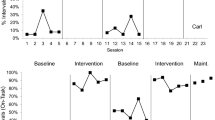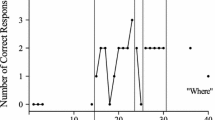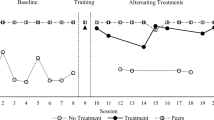Abstract
This study assessed the use of WatchMinder™, a vibrating prompt watch, and self-graphing on the on-task behavior of students with autism spectrum disorder in an elementary special education setting. Using a multiple baseline across subjects design, results showed an immediate increase in on-task behavior when the intervention was introduced. Participants maintained high levels of on-task behavior during the follow-up phase. Implications for expanded self-monitoring treatment packages are discussed.

Similar content being viewed by others
Explore related subjects
Discover the latest articles and news from researchers in related subjects, suggested using machine learning.References
Amato-Zech, N. A., Hoff, K. E., & Doepke, K. J. (2006). Increasing on-task behavior in the classroom: Extension of self-monitoring strategies. Psychology in the Schools, 43, 211–221. doi:10.1002/pits.20137.
Anderson, A., & Wheldall, K. (2004). The who, what, where, when, and why of self-monitoring of student behavior. Australasian Journal of Special Education, 28(2), 30–64.
Anson, H., Todd, J., & Casseretto, K. (2008). Replacing overt verbal and gestural prompts with unobtrusive covert tactile prompting for students with autism. Behavior Research Methods, 40, 1106–1110.
Bjorklund, D. F. (2012). Children’s thinking: Cognitive development and individual differences. Belmont, CA: Wadsworth/Cengage Learning.
Blick, D. W., & Test, D. W. (1987). Effects of self-recording on high school students’ on-task behavior. Learning Disability Quarterly, 10, 203–213.
Briesch, A. M., & Chafouleas, S. M. (2009). Review and analysis of literature on self-management interventions to promote appropriate classroom behaviors (1988–2008). School Psychology Quarterly, 24, 106–118. doi:10.1037/a0016159.
Callahan, K., & Rademacher, J. A. (1999). Using self-management strategies to increase the on-task behavior of a student with autism. Journal of Positive Behavior Interventions, 1, 117–122. doi:10.1177/109830079900100206.
Farrell, C. A., & McDougall, D. (2008). Self-monitoring of pace to improve math fluency of high school students with disabilities. Behavior Analysis in Practice, 1(2), 25–26.
Gast, D. L. (2010). Single subject research methodology in behavioral science. New York, NY: Routledge.
Green, J. M., Hughes, E. M., & Ryan, J. B. (2011). The use of assistive technology to improve time management skills of a young adult with an intellectual disability. Journal of Special Education Technology, 26, 13–20.
Holifield, C., Goodman, J., Hazelkorn, M., & Heflin, L. J. (2010). Using self-monitoring to increase attending to task and academic accuracy in children with autism. Focus on Autism and Other Developmental Disabilities, 25, 230–238. doi:10.1177/1088357610380137.
Joseph, L. M., & Eveleigh, E. L. (2011). A review of the effects of self-monitoring on reading performance of students with disabilities. The Journal of Special Education, 45, 43–53. doi:10.1177/0022466909349145.
Koegel, R. L., & Koegel, L. K. (1990). Extended reductions in stereotypic behavior of students with autism through a self-management treatment package. Journal of Applied Behavior Analysis, 23, 119–127.
Lee, S., Simpson, R. L., & Shrogen, K. A. (2007). Effects and implications of self-management for students with autism: A meta analysis. Focus on Autism and Other Developmental Disabilities, 22, 2–13. doi:10.1177/10883576070220010101.
Legge, D. B., DeBar, R. M., & Alber-Morgan, S. R. (2010). The effects of self-monitoring with a MotivAider on the on-task behavior of fifth and sixth graders with autism and other disabilities. Journal of Behavior Assessment and Intervention in Children, 1, 43–52.
Mancina, C., Tankersley, M., Kamps, D., Kravits, T., & Parrett, J. (2000). Brief report: Reduction of inappropriate vocalizations for a child with autism using a self-management treatment program. Journal of Autism and Developmental Disorders, 30, 599–605.
McDougall, D., Morrison, C., & Awana, B. (2012). Students with disabilities use tactile cued self-monitoring to improve academic productivity during independent tasks. Journal of Instructional Psychology, 39(2), 119–130.
Miller, K. J., Fitzgerald, G. E., Koury, K. A., Mitchem, K. J., & Hollingsead, C. (2007). KidTools: Self-management, problem solving, organizational, ad planning software for children and teachers. Intervention in School and Clinic, 43, 12–19. doi:10.1177/10534512070430010201.
Milley, A., & Machalicek, W. (2012). Decreasing reliance on adults: A strategic guide for teachers of students with autism spectrum disorders. Intervention in School and Clinic, 48(2), 67–75. doi:10.1177/1053451212449739.
Parker, D., & Kamps, D. (2011). Effects of task analysis and self-monitoring for children with autism in multiple social settings. Focus on Autism and Other Developmental Disabilities, 26, 131–142. doi:10.1177/1088357610376945.
Richards, S. B., Taylor, R. L., & Ramasamy, R. (2014). Single subject research: Applications in educational and clinical settings. Belmont, CA: Wadsworth Cengage Learning.
Sebag, R. (2010). Behavior management through self-advocacy. Teaching Exceptional Children, 42(6), 22–29.
Soares, D. A., Vannest, K. J., & Harrison, J. (2009). Computer aided self-monitoring to increase academic production and reduce self-injurious behavior in a child with autism. Behavioral Interventions, 24, 171–193. doi:10.1002/bin.283.
Trammel, D. L., Schloss, P. J., & Alper, S. (1994). Using self-recording, evaluation, and graphing to increase completion of homework assignments. Journal of Learning Disabilities, 27, 75–81.
Van Hulle, A., & Hux, K. (2006). Improvement patterns among survivors of brain injury: Three case examples documenting the effectiveness of memory compensation strategies. Brain Injury, 20, 101–109.
Wilkinson, L. A. (2008). Self-management for children with high-functioning autism spectrum disorders. Intervention in School and Clinic, 43, 150–157. doi:10.1177/1053451207311613.
Acknowledgments
The authors thank Elisa Cruz-Torres for assisting us with graphing.
Author information
Authors and Affiliations
Corresponding author
Rights and permissions
About this article
Cite this article
Finn, L., Ramasamy, R., Dukes, C. et al. Using WatchMinder to Increase the On-Task Behavior of Students with Autism Spectrum Disorder. J Autism Dev Disord 45, 1408–1418 (2015). https://doi.org/10.1007/s10803-014-2300-x
Published:
Issue Date:
DOI: https://doi.org/10.1007/s10803-014-2300-x




